Transforming an empty room into a vibrant and engaging preschool classroom can be daunting. But fear not, because in this article, we will show you exactly how to do a preschool classroom setup to create an ideal learning and growth environment. Whether you’re a seasoned teacher or a parent looking to create a stimulating space at home, these tips and tricks will help you design the perfect preschool classroom.
The layout of the preschool classroom setup should promote easy supervision and freedom of movement for children. Select appropriate furniture and organizational materials to organize different areas for different activities to meet preschool children’s developmental needs.
With our step-by-step guide, you’ll learn how to optimize the layout of your preschool classroom to ensure maximum engagement and collaboration among your young learners.
So, let’s dive in and discover the secrets to a successful and inspiring preschool classroom setup.
Planning Your Preschool Classroom Layout

The first thing to do with a preschool classroom setup is to check out the layout of the preschool classroom. You will find a lot of problems through the preschool classroom floor plan. Find out what areas of the classroom cannot be modified, such as the doors, windows, and walls.
Consider the room’s flow and how the children will move through the different areas. It is important to create clear pathways and separate areas for different activities.
Consider the different learning centers or areas you want to combine when planning your layout. These may include reading corners, art stations, science exploration areas, dramatic play areas, and sensory tables. Arrange furniture and materials to allow for easy access and transitions between these areas.
It is a good idea to set up similar areas together, such as keeping noisy areas in one area with other noisy areas and keeping quiet areas in one area.
It is also important to consider the size of the classroom and the number of children it will accommodate. Make sure there is enough space for children to move around freely and that each learning area has enough room for multiple children to engage in activities simultaneously. In addition, make sure that furniture and materials are child-sized and easy to use.
Essential furniture and materials for a preschool classroom setup
Here are some essential items you should consider incorporating:
1. Tables and Chairs:
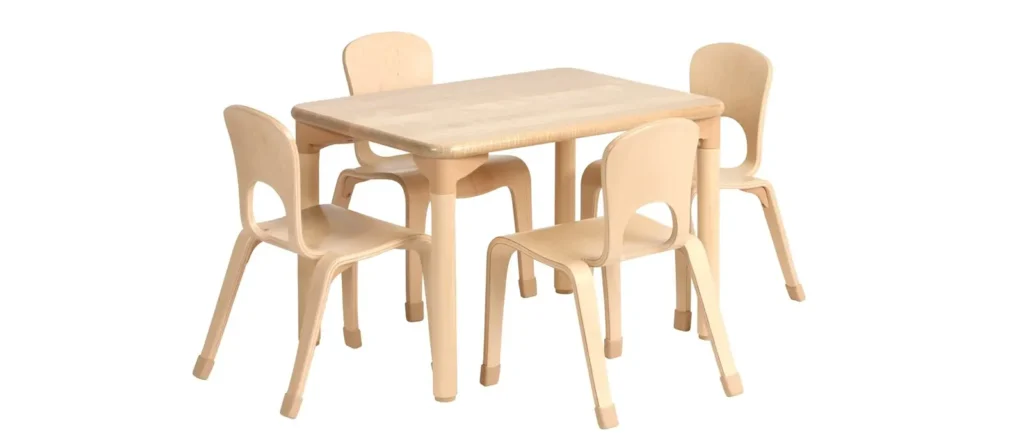
Provide child-sized tables and chairs that are sturdy and comfortable. Opt for furniture in bright colors to create a welcoming atmosphere.
2. Storage Units:
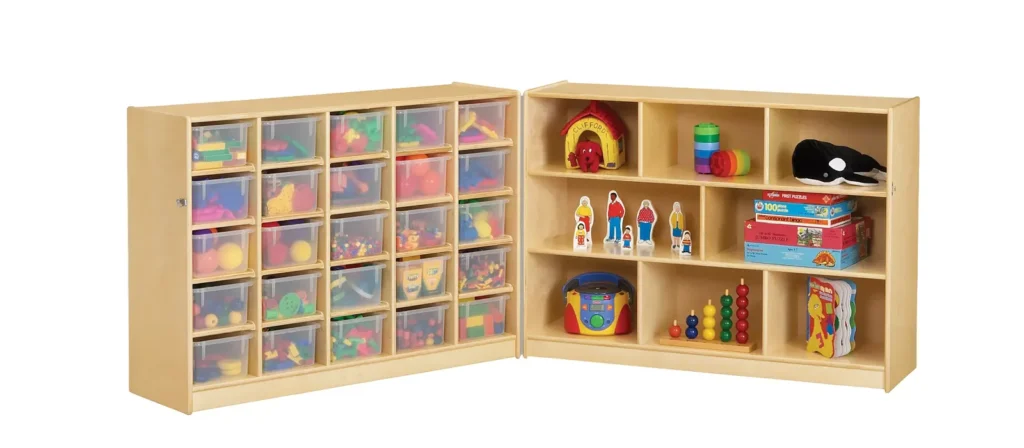
Invest in storage units with open shelves or bins that are easily accessible for children. This will help keep materials organized and within reach.
3. Book Display:

Set up a book display area with low bookshelves or baskets to showcase a variety of age-appropriate books. Ensure books are easily accessible and displayed with their covers facing forward to entice children to explore them.
4. Art Supplies:
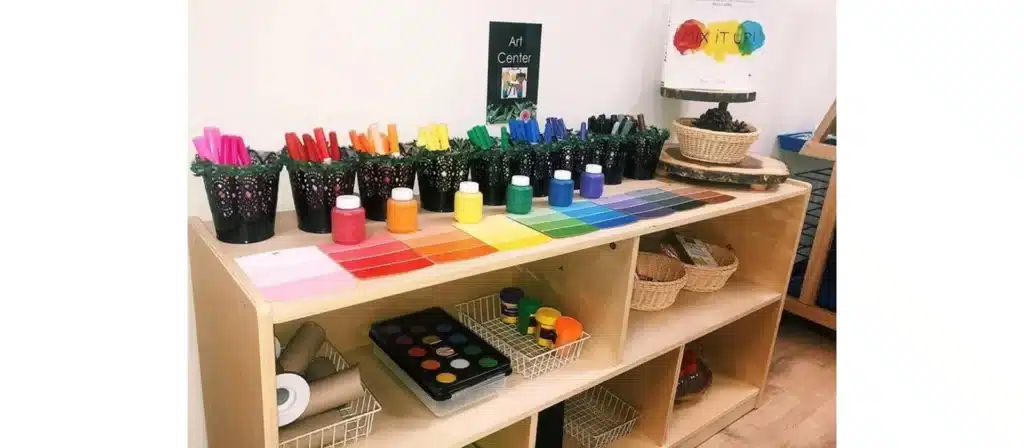
Stock your art station with various art supplies, such as crayons, markers, colored pencils, paint, brushes, and paper. Consider including materials like glue, scissors, and recyclables for open-ended art projects.
5. Manipulatives:
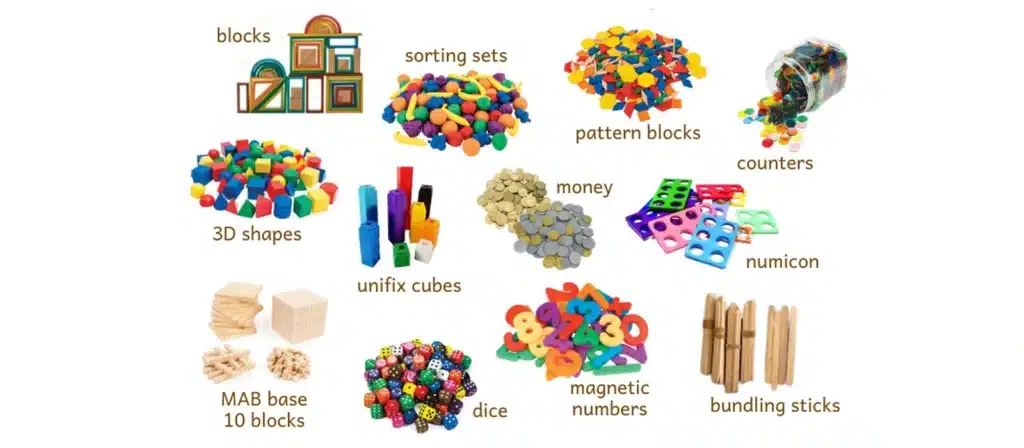
Provide various manipulatives, such as blocks, puzzles, counting toys, and sorting materials. These hands-on materials promote fine motor skills, problem-solving, and cognitive development.
6. Sensory Materials:

Include sensory materials like sand, water, playdough, and sensory bins filled with rice, beans, or natural materials. These materials stimulate the senses and encourage exploration and creativity.
Regularly rotate and refresh materials to keep children engaged and excited about learning.
Setting up different areas in a preschool classroom
Preschool classroom setup should consider creating specific areas for different learning activities. Here are some key learning areas you should consider incorporating:
Keeping children engaged and facilitating a love for learning requires a stimulating environment that is adaptive to their evolving needs.

Reading Corner
Create a cozy and inviting reading corner with comfortable seating, soft pillows, and various books. Use a rug or carpet to define the space and make it warm and inviting.
Science Exploration Area
The Science Exploration Area is a laboratory for young minds that allows children to conduct hands-on science experiments and exploration. Includes magnifying glasses, magnets, sensory materials, and age-appropriate science books.


Dramatic Play Area
Set up a dramatic play area with props, costumes, and pretend play materials. Provide opportunities for children to engage in imaginative play and role play.
Math and Manipulative Area
An area dedicated to math activities and manipulatives. Includes counting toys, organizing materials, puzzles, and math games to promote early math skills.

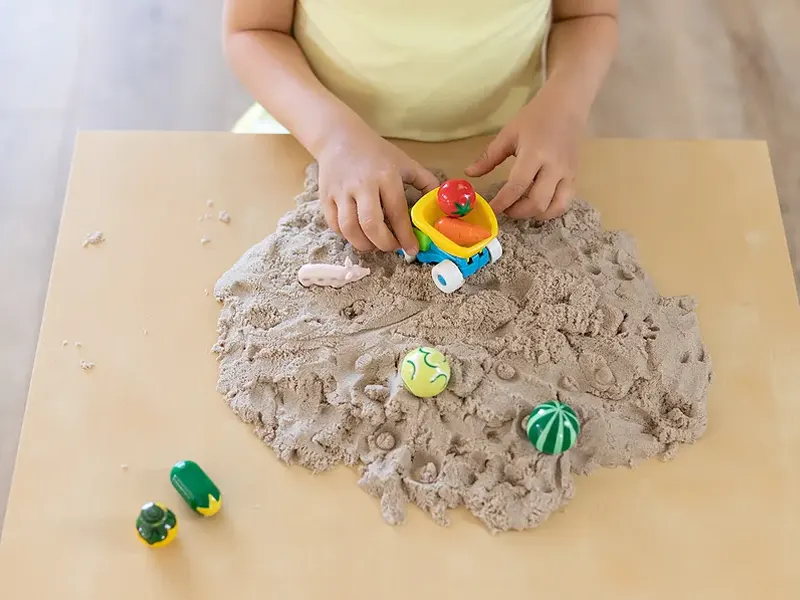
Sensory Area
Set up a sensory table with different sensory materials where children can use their senses to explore. This area provides opportunities for sensory play and scientific exploration.
Block Area
The neighborhood area supports spatial awareness, motor skills, and creativity. Block centers contain wooden blocks, figures, animals, paper, pencils, felt pieces and fabrics, wooden log pieces, train tracks, vehicles, Depot blocks, dolls, magnetic boards, and more!
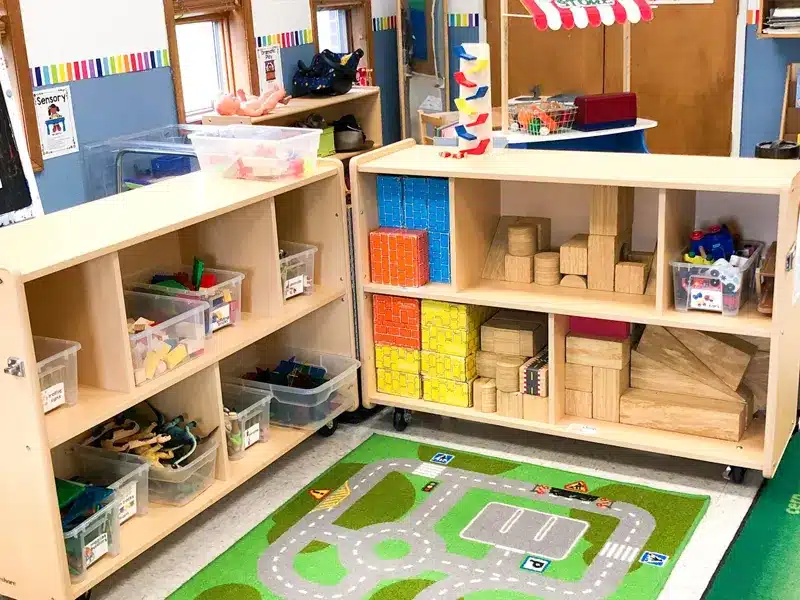

Alphabet Center
Provides activities and materials focusing on letter recognition, phonics, and early writing skills. Equip this space with magnetic letters, alphabet puzzles, tracing materials and interactive games.
Outdoor Play
If an outdoor area is intended. This area should include equipment such as swings, slides and balance beams, and open areas for movement and play. Natural elements like gardens, sandboxes, and water play stations can provide sensory experiences and environmental education opportunities.

Organizing preschool classroom supplies and materials
Want to keep your preschool classroom supplies and materials organized? Here are some tips for organizing your preschool classroom supplies:
- Labeling: Use clear or picture labels to identify storage areas and materials. This will help children easily locate and put away items.
- Bins and Containers: Invest in storage bins and containers of various sizes to keep materials sorted and easily accessible. Label each bin with its contents to facilitate organization.
- Rotating Materials: Rotate materials regularly to keep children engaged and interested. Store extra materials in a separate area and introduce them periodically to maintain novelty.
- Accessibility: Ensure materials are stored at the child level to promote independence and easy access. Consider using open shelves or transparent containers so children can see what’s inside.
- Clean-Up Routine: Establish a clean-up routine to teach children responsibility and organization. Set clear expectations and provide visual cues to guide children in returning materials to their designated places.
By implementing these preschool classroom setup, you can create an organized and efficient classroom environment that promotes independence and maximizes learning opportunities.
Preschool classroom setup decoration and theme ideas
Preschool classroom setup decoration and theme can enhance the learning environment and create a welcoming atmosphere. Here are some decoration and preschool theme ideas to consider:

1. Colorful Walls: Preschool classroom setup with bright, exciting colors that create a positive and energetic ambiance. Consider using murals or wall decals with educational themes or nature scenes.
2. Bulletin Boards: Use bulletin boards to display children’s artwork, achievements, and important information. Change the displays regularly to showcase different themes or topics.
3. Themed Areas: Create themed areas within your classroom, such as a jungle, space, or ocean theme. Use props, posters, and decorations to bring the theme to life and make learning more engaging.
4. Classroom Rules and Expectations: Preschool classroom setup needs to consider displaying classroom rules and expectations. Use pictures or symbols to help young children understand and remember the rules.
5. Children’s Work: Showcase children’s artwork, writing, and projects throughout the classroom. This celebrates their achievements and creates a sense of pride and ownership.
When decorating your preschool classroom, remember to strike a balance between stimulating and overwhelming. Keep decorations purposeful, age-appropriate, and aligned with your educational goals.
Safety considerations in a preschool classroom setup
A preschool classroom setup requires regular inspections for safety hazards and prompt resolution. Establish clear safety rules and routines and teach children about safety practices to ensure a secure learning environment.
Safety is of utmost importance in a preschool classroom. Here are some safety considerations to keep in mind:
1. Preschool Furniture Stability
Ensure that all furniture is stable and securely anchored to prevent tipping. Regularly check for loose screws or wobbly pieces.
2. Sharp or Hazardous Materials
Keep sharp or hazardous materials, such as scissors, glue guns, or cleaning supplies, out of children’s reach. Store them in locked cabinets or high shelves.
3. Fire Safety
Install smoke detectors and fire extinguishers in your classroom. Create and practice a fire escape plan with your students.
4. First Aid Kit
Keep a well-stocked first aid kit easily accessible in case of minor accidents or injuries.
Things to keep in mind when setting up a preschool classroom
Selecting the perfect preschool setting involves more than just a cursory glance at the decor. It’s about ensuring a space that nurtures, educates, and safeguards our little ones.
A well-thought-out preschool classroom setup should blend safety, learning, and play seamlessly. This includes incorporating natural elements, designing an inviting entrance, managing noise levels, ensuring constant supervision, and clearly defining boundaries.
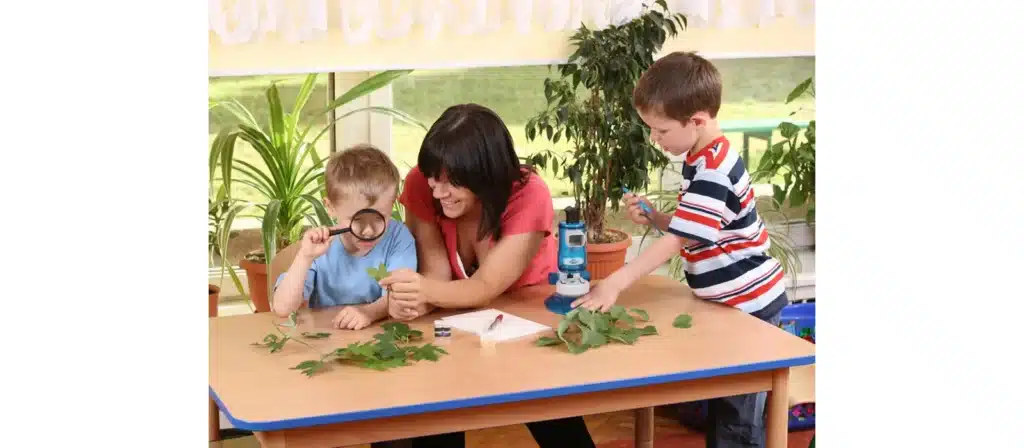
1. Incorporate Nature Into Your Classroom
Incorporating nature into the preschool classroom is more than just adding a few plants here and there. Help create a connection between children and the natural world. Use natural materials like wood, stone, and fabric to bring the feeling of the outdoors inside.
Incorporate a variety of plants that kids can care for to teach them the basics of responsibility and biology. Create a small indoor or butterfly garden near a window to provide hands-on learning opportunities about ecosystems.

Utilizing as much natural light as possible saves energy and creates a warm, welcoming atmosphere. Displaying nature-themed artwork and photographs can inspire curiosity about the world and promote discussion about the importance of different environments and conservation.
2. Creating an Engaging Entrance
The entrance to a preschool classroom sets the tone for what’s inside. It should be welcoming and visually appealing to children and their parents. Use bright colors, kid-friendly signs and children’s artwork displays to make the entrance appealing.
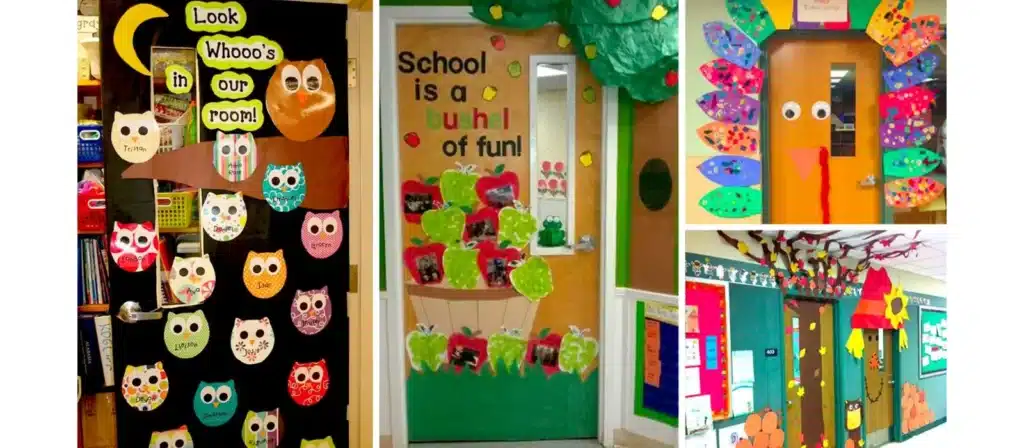
Consider a welcome mat with the classroom’s name or theme and a photo board with photos of the children involved in activities. This area can also serve as an information center for parents, with a bulletin board that provides the latest news, schedules and announcements of upcoming events.
The preschool classroom entrance is more than just a transitional space; it’s the first chapter of a day’s learning adventure.
3. The noise factor
Excessive noise can overwhelm children and make concentration and communication difficult. Use soft furnishings and materials such as carpeting, curtains and mats to absorb sound. Designate quiet activity areas away from noisy areas and use shelves or partitions to create a natural sound barrier. Implementing “quiet zones” can provide refuge for children who need a break from the noise. Teach children appropriate times for indoor sounds and loud play, using games and visual cues to reinforce these concepts.
4. The supervision factor
The preschool classroom setup layout should allow teachers to see and reach every child easily, without obstructions. Arrange furniture and activity areas to maintain open lines of sight, ensuring that children are always within view. This setup prevents accidents, helps manage behavior, and facilitates interactions among children. Regularly evaluate the classroom arrangement to adapt to the dynamic nature of preschool activities and the changing needs of the children.
5. The boundary factor
Clear boundaries within the preschool classroom help children understand where they can go, what they can do, and how to navigate the space safely. Use physical markers like rugs, floor tape, or colored tiles to delineate specific areas. Establishing these boundaries supports children’s independence by allowing them to make choices within a safe framework. It also aids in classroom management, helping children learn to respect their peers’ space and activities.
Classroom Management Strategies for a Successful Setup
By implementing these strategies, you can create a positive and inclusive classroom environment that fosters cooperation, engagement, and a love for learning.
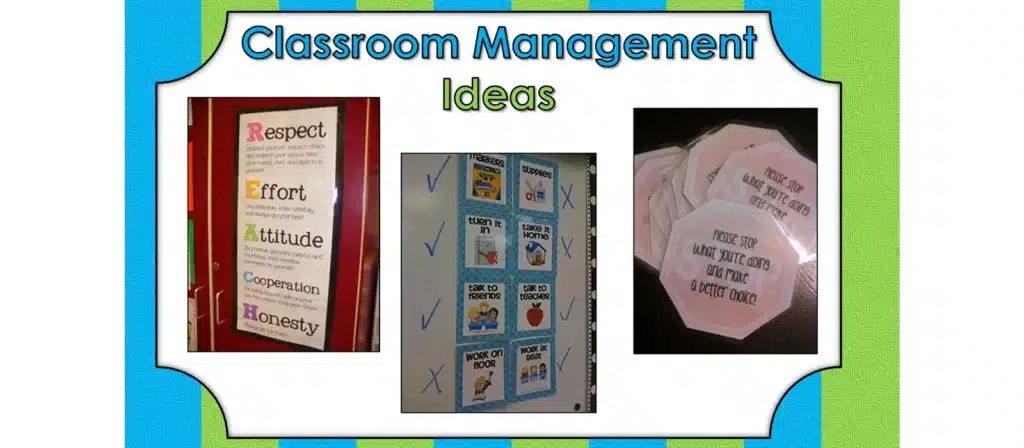
- Establish Rules and Expectations: Communicate and consistently reinforce classroom rules and expectations. Use positive language and provide visual cues to help young children understand and remember the rules.
- Transitions and Routines: Establish predictable routines and smooth transitions between activities. Use visual cues like timers or songs to signal transitions and provide a sense of structure.
- Positive Reinforcement: Encourage and reinforce positive behavior through praise, rewards, stickers, or tokens. Celebrate achievements and milestones to motivate children.
- Clear Communication: Use clear and straightforward language when giving instructions or explaining expectations. Use visual cues, gestures, or pictures to support understanding.
- Individualized Support: Recognize and address the individual needs of each child. Provide additional support or modifications to activities as needed.
- Collaborative Problem-Solving: Encourage children to solve problems collaboratively and teach conflict resolution skills. Help children understand and express their emotions appropriately.
Budget for preschool classroom setup
Creating a preschool classroom setup requires careful planning and budgeting. Allocate funds for basic furniture, educational materials, and safety features. A well-structured budget helps ensure that funds are allocated wisely so that items directly impacting children’s learning experience and safety can be prioritized.
Determining your budget includes assessing the needs of your classroom, prioritizing essential items, and researching cost-effective solutions. List all the furniture, materials, and equipment you need. Consider the longevity and versatility of each item to ensure value for money.
- Prioritization of needs: by identifying and listing necessary items for the classroom, you can prioritize them so that they are secured first, such as safety equipment, educational materials, and appropriate furniture.
- Financial management: prevent overspending by outlining specific cost estimates for each category or item. Helps avoid unnecessary expenses and ensures that funds are available for all programmatic aspects of the classroom setup.
- Long-term savings: Investing in durable, high-quality furniture and equipment may be more expensive initially but can lead to long-term savings. High-quality items typically last longer and are replaced less frequently.
- Resource allocation: a comprehensive budget allows for funds to be allocated to different areas of the classroom. This includes immediate necessities such as furniture and learning materials and long-term investments in technology, teacher professional development, and contingency funds for unexpected expenses.
Conclusion
Preschool classroom setup can be a challenging but rewarding task. By considering the importance of organization, planning the best layout, selecting appropriate furniture and materials, creating designated areas, organizing supplies, decorating with purpose, prioritizing safety, and implementing effective classroom management strategies, you can create an environment that nurtures young minds and promotes curiosity.
Every child is unique, and it’s important to create a classroom that meets their individual needs and interests. Constantly observe and adjust your preschool classroom setup based on the feedback and reactions of your young learners. With the right setup, classrooms become spaces where children can thrive, explore and grow.












